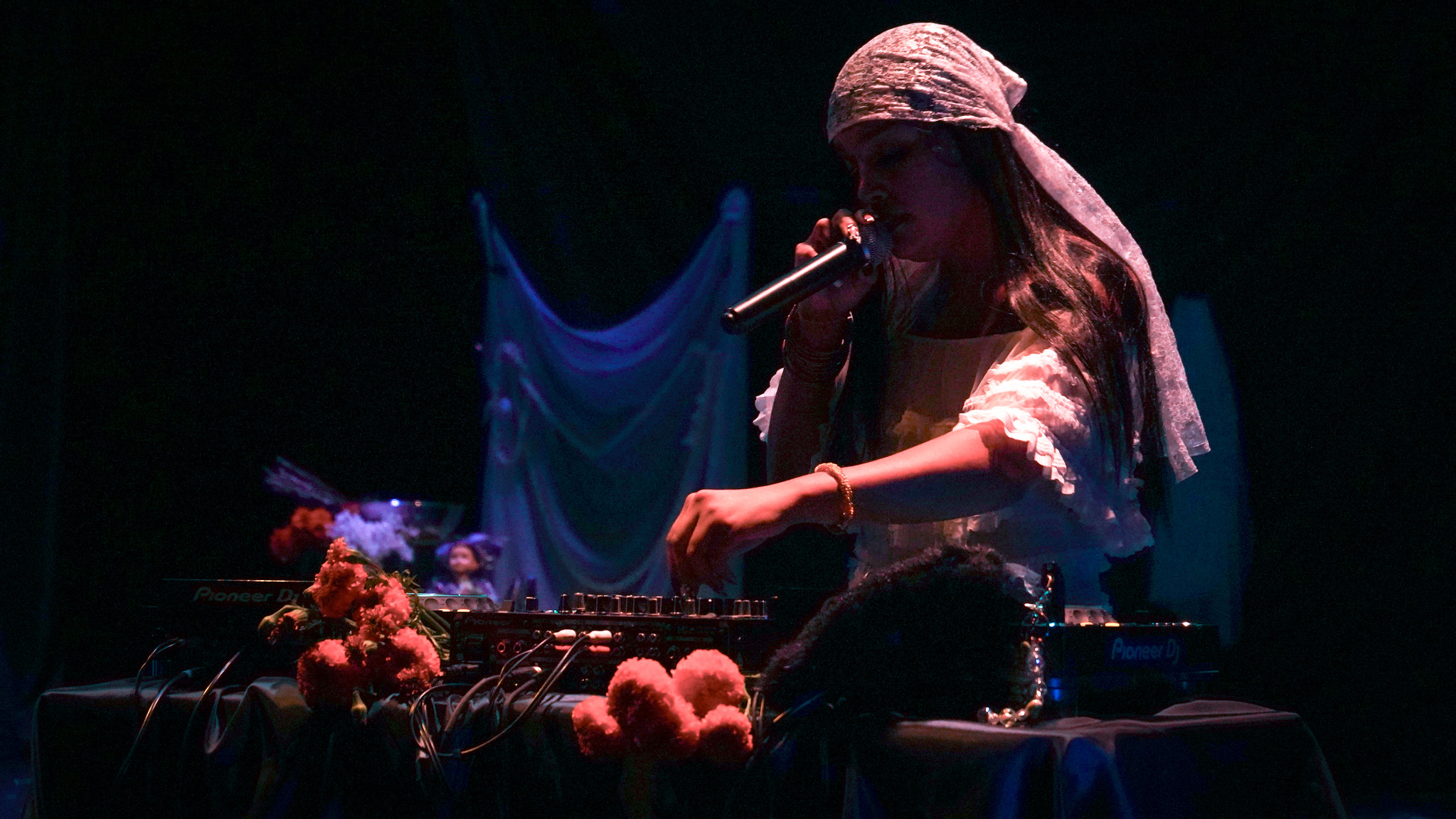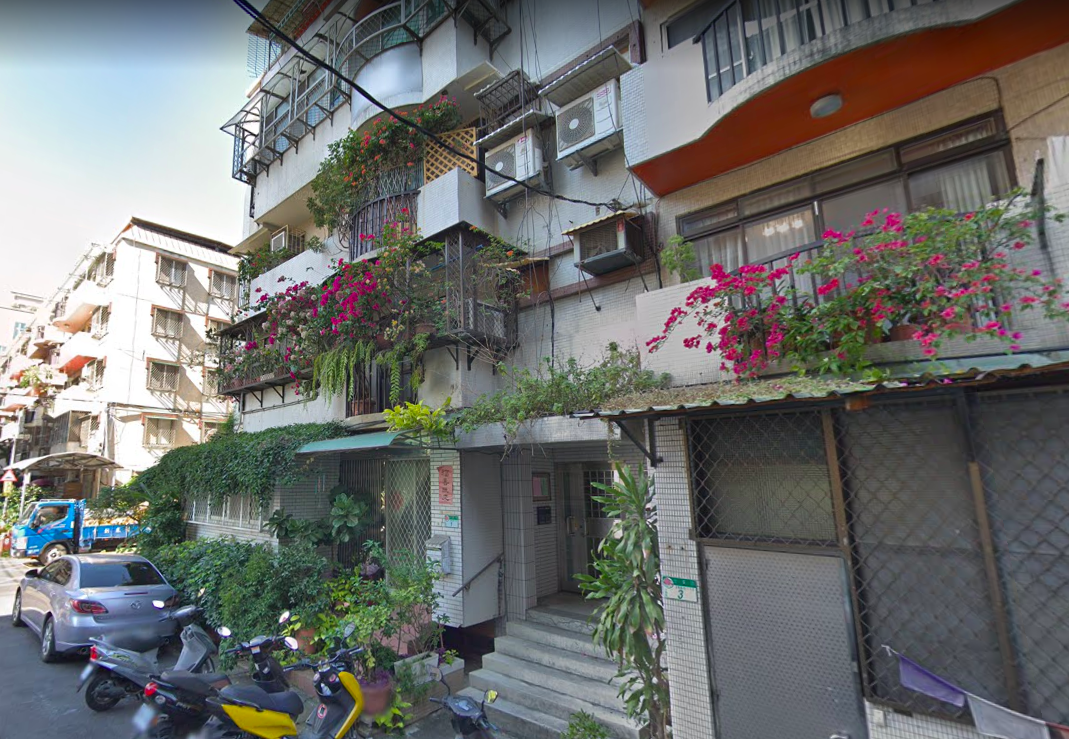As part of the pilot CounterPulse Performance and Technology Combustible — a residency model for artists collaborating with creative technologists— we hosted two work-in-progress labs last week for participating artists: Capacitor with collaborator Zach Howard, and Dohee Lee with collaborator Donald Swearingen.
Dohee Lee and Donald Swearingen were first to show their work. Dohee is a dancer, vocalist, and musician who draws on the artistic forms and shamanistic rituals of her native Korea to inform her contemporary performance practice. Donald is a composer and musician who has long worked with technology in both his musical experimentation as well as his programming day job. The two have been collaborating for years but their current project is by far their most technologically sophisticated. With ARA: Waterways Time Weaves, they’ve affixed motion sensors to Dohee’s body that have been programmed to interact dynamically with a synthesizer and score developed by Donald.
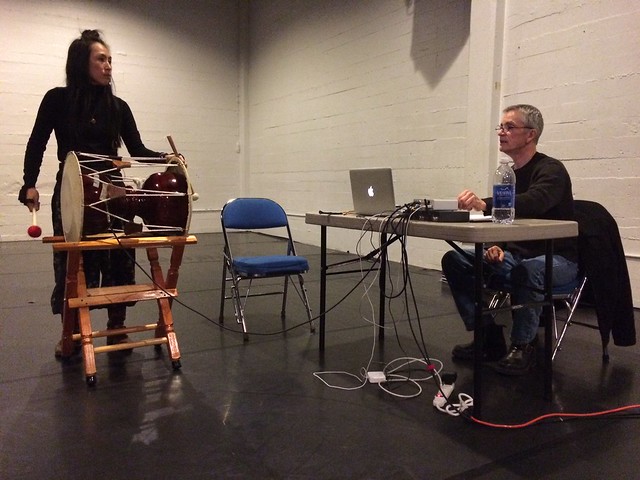
Photo: Shamsher Virk; Pictured: Dohee Lee, Donald Swearingen
Donald prepared the electronics on a table set downstage for the audience to see. A nest of cables connected a laptop to a radio transceiver. Dohee positioned herself center stage, ten feet away, next to a large wooden drum. We could see two motion sensors attached to the backs of her fingerless gloves. A wireless mic was barely visible, reaching from above her ear down near her mouth.
Dohee began to vocalize. She raised her hands and modulated the sound coming from her mouth using the nuanced movements of a conductor or a magician. Waves of hypnotic sound filled the room, seeming to emanate from Dohee and echo throughout the space. An imagined ocean was clearly audible in this liquid sea of sound.
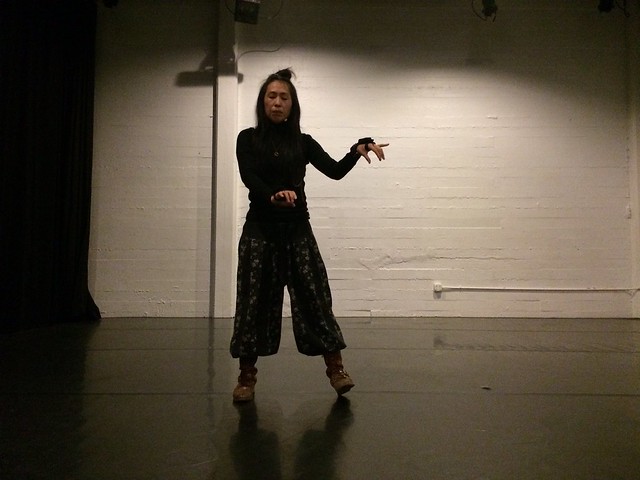
Photo: Shamsher Virk; Pictured: Dohee Lee
Having performed a few examples of the material their generating together, Dohee and Donald took us behind the wizard’s green curtain to explain how they created the sound modulations using the motion sensors. The two wireless sensors pick up movement on three axes. Each axis can be assigned to and control a different variable in the sound: pitch, delay, and percussion, for example. Other variables are programmed by Donald to produce different timbre and effects throughout the duration of a piece. Dohee has developed a movement vocabulary that transforms her body into an instrument that can be played. They will continue to refine the movement control and programming as their collaboration continues in the coming months.
A few days later, we gathered again to view work-in-progress by Capacitor, the other group participating in the pilot residency. Artistic Director, Jodi Lomask, explained a few basic parameters of the piece we were about to see excerpted. Two dancers took the stage and demonstrated a choreographic sequence that will eventually be set on five dancers. A simple metronome carried the dancers forward in place of the music that will guide the final production. The dancers were costumed in black skirts fabricated from strips of black material that looked like rubber or leather. They moved downstage with athleticism and energy, extending their limbs in balletic strokes, coming into contact with one another and then splitting off to pursue their own path. Their black skirts lifted and swirled around them as they spun, making slapping sounds that added to the percussion of the metronome.
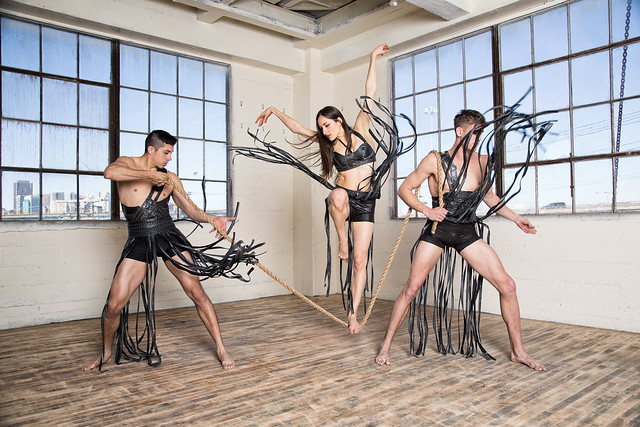
Photo: Eric Raeber; Pictured: Ismael Acosta, Michelle Ellis, Micah Walters
Jodi asked us questions about what we learned watching the dance. She was curious to know what “problem” we thought the dancers were trying to solve with their movement. The strong centrifugal and centripetal movement gave the observing staff the impression that they were seeing two planets orbiting each other, rotating and revolving. The costuming elicited some apocalyptic interpretations, conjuring images of Mad Max and a dungeon keeper. A contrast emerged between the elegance of the dancers’ movement and the rigid nature of the costuming. Our focus was drawn to the dancers’ pelvis and hips by the central role of the skirt in the dance.
We were then joined by one of Capacitor’s collaborating technologists, Zach Howard. Zach has been working in Autodesk’s AutoCad to design a costume/prop for Capacitor that will function as both a cape to be worn by dancers, and a throne that they can sit upon. He’d brought a prototype of the cape/throne with him to demonstrate the mechanics and solicit feedback. We passed the prototype around, manipulating it and discussing its properties. Its shape suggested to us that of a ladder or bullet belt. Our conversation gave Zach and Jodi feedback about the dimensions of the object and weight of the materials. They’re also working on a collection of other costumes and props for dancers to wear and dance with (one such object is pictured below). We’re eager to see the next prototype and watch the dancers begin to interact with it.
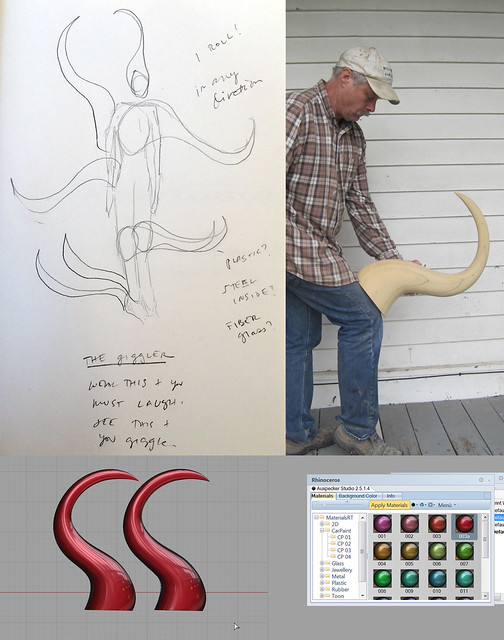
Development of “The Giggler”; Courtesy of Capacitor
If you’d like to see Capacitor’s work for yourself, they will be showing an excerpt of their most recent piece, Synaptic Motion, during the Market Street Prototyping Festival, April 9-11, at the CounterPulse Show Box stage on the north side of Market Street between 6th and 7th street. Dohee Lee will continue the development of ARA: Waterways Time Weaves over the next year with presentation of the final performance in fall 2016. Stay tuned for future opportunities to see the work in development.
Share This!
More Good Stuff
Ātl Verde: "Ātl," the Nahuatl word for water, symbolizing the river flowing through my evolution—connecting past, present, and future. This piece reflects my journey as
Unsettled/Soiled Group is a group of East, Southeast, and South Asian diasporic movers, makers, and settlers on Ramaytush and Chochenyo Ohlone land. Unsettled/Soiled Group is led by June Yuen Ting, one of CounterPulse's 2022 ARC Performing Diaspora artists and will debut Dwelling for Unsettling alongside VERA!'s Try, Hye!, Thursday through Saturday, December 8-10 & 15-17, 2022
VERA! (they/them) is a queer Armenian American drag king, dancer, and community activist. They are one of CounterPulse's 2022 ARC Performing Diaspora artists and will debut Try, Hye! alongside Unsettled/Soiled Group's Dwelling for Unsettling, Thursday through Saturday, December 8-10 & 15-17, 2022

